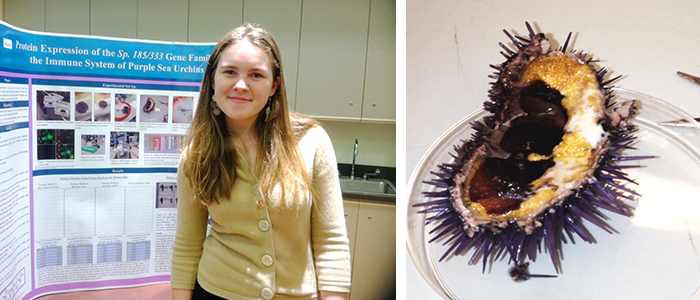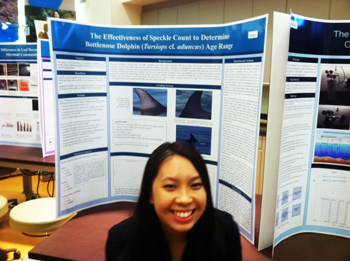For the fourth consecutive year, a School Without Walls High School student won the grand award from the DC Citywide STEM Fair, the district's largest STEM competition, on Saturday, March 22, 2014. In fact, three students from School Without Walls HS swept the grand awards, coming in 1st, 2nd, and 3rd place and winning an all-expense paid trip to Los Angeles, CA to represent DC at the Intel International Science and Engineering Fair in May. Students in the high school division competed against over 100 other high school students from DC's public, public charter, private, and parochial schools.
Below are Kelsey, Marcelle and Maya describing their project in their own words.

Kelsey White -
3rd Place:School Without Walls HS, The effect of ocean acidification on planarian regeneration (Animal Sciences category)
My project was focused on the potential affect of ocean acidification on stem cell processes by looking at planaria as a model. I chose this project because the ocean and aquatic systems have been of great interest to me since I was young, as well as biology and the study of animals. I am also interested in the impact humanity has had on the environment, and after learning that ocean acidification is one of the more harmful affects of human activity I wanted to do my science fair project on this as understanding more about ocean acidification's potential impact on life and biological processes is highly important.
 My experiment involved setting up a system of decreasing the pH level of water using carbon dioxide to best mimic ocean acidification, and seeing how this would affect the growth rate of planaria after being bisected. I chose to experiment on planaria as their regenerative abilities are astounding (it has been recorded that a section a 300th the size of the original organism can regenerate into a full living worm) and involve many stem cell processes, and in addition planaria are fairly cheap and easy to care for.
My experiment involved setting up a system of decreasing the pH level of water using carbon dioxide to best mimic ocean acidification, and seeing how this would affect the growth rate of planaria after being bisected. I chose to experiment on planaria as their regenerative abilities are astounding (it has been recorded that a section a 300th the size of the original organism can regenerate into a full living worm) and involve many stem cell processes, and in addition planaria are fairly cheap and easy to care for.
I had many setbacks in my experiment due to time and resources, but despite this I was able to place first in my category and third overall at the DC STEM Fair. I am honored to be traveling to Los Angeles in May to participate in the INTEL International Science and Engineering Fair, and am very excited to have been continuing my research in preparation for this and for the opportunity to meet others my age who are interested in science from all over the world.

Marcelle Snead
2nd Place: School Without Walls HS, Protein Expression of the sp. 185/133 gene family in the immune system of purple sea urchin (Cellular and Molecular Biology category)
My science senior project was about the immune system of Purple Sea Urchins. Through the sequencing of the Purple Sea Urchin genome, researchers have found many similarities between their immune system and that of humans, more research into the immune system of these animals may be used as an evolutionary model for the development of the adaptive immune system.
In my paper I argued that Purple Sea Urchins should be used as an evolutionary model, using the research from my product, along with outside research, as evidence. For my product, I looked at how a specific gene family within the immune system of the Purple Sea Urchins responded to different bacteria. I presented my project at the DC STEM fair and won second in the overall fair. I will be going to LA in May to present at the Intel International Science and Engineering Fair.
 Maya Hall -
Maya Hall -
Grand Award (High School)
1st Place: School Without Walls HS, The effectiveness of speckle count to determine the age range of bottlenose dolphins (Behaviorial and Social Sciences category)
My project focused on finding an alternative method to aging bottlenose dolphins off the coast of Western Australia. Currently, if researchers need to determine the age of a dolphin, they must extract a tooth and examine the calcium layers, which is similar to aging a tree by its rings. This process is invasive and time consuming, and is dangerous for both researchers and dolphins.
An alternative method is using speckle count to determine an age range. Speckles are marks on a dolphin’s body and dorsal fin that appear darker than the rest of the skin. Using a database of dolphin dorsal fin images from a laboratory at Georgetown University, I evaluated age versus speckle number for many different individual dolphins. I chose this project primarily because I am interested in studying marine biology in college, and I had the opportunity to do an internship at the Mann Laboratory at Georgetown University. I found the lab first, and after a month or so of working for them, I asked to begin my own project. The people of the lab were so generous and provided me with a lot of help. I am still so amazed that full-time researchers would take the time and energy to sit down with me and go through things like statistics. This project was such an interesting project to work on, and I am very thankful for the people that helped me through it.
Being able to go to L.A. to present my work is very exciting. I expect to find a lot of like-minded people there, and hope to make some fun connections. Of course I am interested to hear some conferences and expert-talks, but I’m mostly looking forward to seeing other people’s projects. There have been some absolutely incredible and complicated projects that have won in previous years, so I’m curious to see what will take the prize this year. In total, I am glad to have gotten this chance to go and learn more about what others are doing in the scientific community.


